|
Weather Conditions inKhartoum, SUDAN

Details
|
About Sudan
Sudan is a very safe
place to live in.
Please contact our X
and/or existing native speakers from the Western part of the
world for more information about Sudan and the school.
Please
Visit
Recreational Program
page
and
Testimonials Page
The
major problems in Sudan:
- There is a
social life for the western people but it is limited, being an
alcohol free country, but there are other outlets .You may go
swimming, make some friendship with Sudanese people, go for
picnics, visit famous local places and take membership in
several of the western clubs in Khartoum, which offer sports
facilities, it is also quite cheap to travel to other parts of
Africa and we can agree if the contract allows, mutually
acceptable holiday breaks.
- The heat, it is a
real problem for the western people coming to Sudan .The weather
is at hottest From June to September it is 40+ degrees and heavy
rain. From October to April it is for some extent
reasonable (28+ degrees without rain)
-None stapled
electricity power supply, (the school has generator).
-The mentality of the
Sudanese people. No job can be done on time and many other
issues which are common in the third world, but they are so
friendly and well meaning that you can forgive them anything.
Sudan: Places of Interest
CITC Sudan
used to arrange regular trips for the staff to visit Begrawiya
Pyramids , Jabal Aowlya Dam , Nile River Sailing and Sabaloga
falls.
See the Map of Sudan
Khartoum and
Omdurman
Khartoum is
one of three sister cities, built at the convergence of the Blue
and White Niles: Omdurman to the north-west across the White
Nile, North Khartoum, and Khartoum itself on the southern bank
of the Blue Nile.
Khartoum has a
relatively short history. It was first established as a military
outpost in 1821, and is said to derive its name from the thin
spit of land at the convergence of the rivers, which resembles
an elephant's trunk (khurtum). Khartoum grew rapidly in
prosperity during the boom years of the slave trade, between
1825 and 1880. In 1834 it became the capital of the Sudan, and
many explorers from Europe used it as a base for their African
expeditions.
Khartoum was
sacked twice during the latter half of the 19th century -- once
by the Mahdi and once by Kitchener when the Mahdi was ousted. In
1898, Kitchener began to rebuild the city, and designed the
streets in the shape of the British flag, the Union Jack, which
he hoped would make it easier to defend. On the opposite bank of
the Nile, North Khartoum was developed as an industrial area at
about the same time.
Today's
Khartoum is a quiet, unremarkable city. It has peaceful,
tree-lined streets, and in some ways still bears the
unmistakable mark of an outpost of the British Empire. Its
expansion to accommodate a rapidly-growing population, however,
has added very little in terms of charm or atmosphere. |
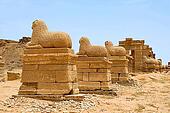
Temple of Amun
lined by rams in Naga.
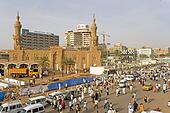
Sudan, Khartoum,
around the Great Mosque
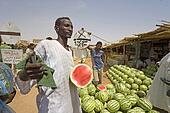
Sudan,
selling watermelons


Pajrawia Pyramids
More photos About Sudan-1
More photos About Sudan-2
More photos About Sudan-3
|
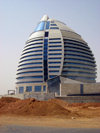
Khartoum: Burj Al-Fateh Hotel, in
the shape of a boat with a full sail, known as 'Gaddafi's Egg' -
Libyan financed hotel located near Tuti island, at the meeting
point of the Blue Nile and White Nile

Omdurman / Umm Durman: tomb of
the Mahdi, Muhammad Ahmed Al Mahdi, Muslim religious leader
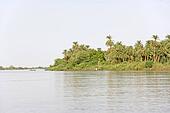
Sudan, The Sixth
Cataract
of the Nile
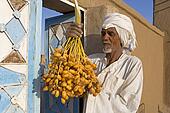
Sudan, Selling fresh dates

|
|
Places to
visit in Khartoum
National
Museum. This contains antiquities and artefacts from several
periods of Sudanese history and pre-history, including
glassware, pottery, statuary and figurines from the ancient
kingdom of Cush. Ancient Nubia's Christian period is
well-represented, with frescoes and murals from ruined churches,
dating from the 8th to the 15th century. The Museum's garden
contains two reconstructed temples, which have been salvaged
from the Nubian land flooded by Lake Nasser. These Egyptian
temples of Buhen and Semna were originally built by Queen
Hatshepsut and Pharaoh Tuthmosis III respectively. The temples
have corrugated iron covers built over them to protect them from
humidity during the wet season. The original concept was to roll
back these covers during the dry season, but whether this ever
happened or not is unclear. The covers are rusted into place and
are now permanent and immovable!
Ethnographical
Museum. This is a small museum which contains an interesting
collection of items relating to Sudanese village life. These
include musical instruments, clothing, cooking and hunting
implements. |
|
Places to
visit in Omdurman
Souq. This is
the largest in the Sudan, and has an interesting variety of
goods on display. Ivory and ebony candlesticks are carved by
market craftsmen, goldsmiths and silversmiths fashion all kinds
of jewellery in their shop-fronts, and the atmosphere is lively
and bustling. The best time to visit is on Friday mornings.
Camel Market.
This is situated about 2km north of Omdurman's main souq.
Animals are mostly brought from eastern or western areas of the
Sudan.
Tomb of the
Mahdi. On the death of the Mahdi in 1885, his body was entombed
in a silver-domed mosque in Omdurman. This was completely
destroyed by Kitchener in 1898, when the Mahdi's body was burned
and his ashes thrown into the river. In 1947 the Mahdi's son had
the mosque and tomb rebuilt. Not surprisingly, it is closed to
foreigners, but can be viewed from the outside.
Beit
al-Khalifa. This is situated opposite the Mahdi's tomb. Once the
home of the Mahdi's successor, the house was built of mud and
brick in 1887, and is now a museum. It contains relics from
Mahdiyya battles, including guns, war banners and suits of mail.
An interesting collection of photographs depicts the city of
Khartoum at the time of the Mahdi's revolt and its subsequent
occupation by the British.
 |
|
Approved By
University
of Cambridge
 |
Cambridge International (Sudan)
Head Office
Khartoum - Arkweet - Nakheel Street Ext.
Tel.
249-183-521313 - Fax - 249-183--521312
P.0.Box - 15018 - Code -
12217
Email:
jobs@citcsudan.org
|
|
|